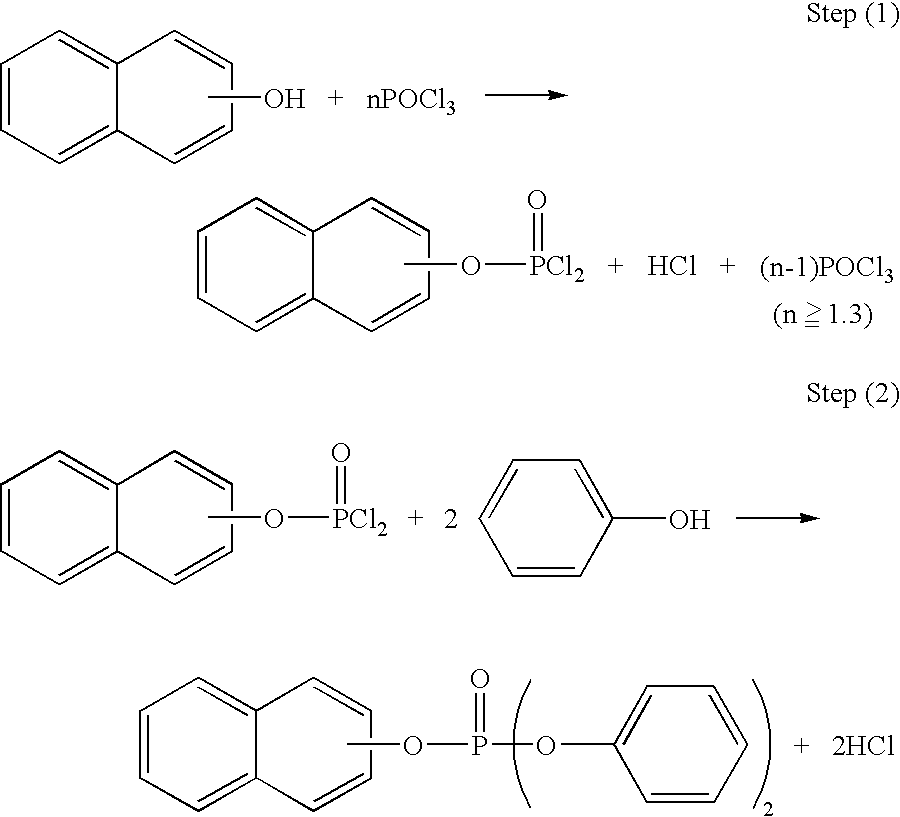Process for preparing phosphoric esters
- Summary
- Abstract
- Description
- Claims
- Application Information
AI Technical Summary
Benefits of technology
Problems solved by technology
Method used
Image
Examples
example 1
[0058] Into a one-liter four-necked flask provided with a stirrer, a condenser and a thermometer, 144.2 g (1 mole) of 2-naphthol, 199.4 g (1.3 moles) of phosphorus oxychloride and 0.5 g of anhydrous magnesinum chloride were fed. Then, the resulting mixed solution was heated with stirring in nitrogen atmosphere to 120.degree. C. in an hour, and then reacted by stirring at the same temperature (120.degree. C.) for an hour. After the reaction, the pressure was reduced to about 1.5 kPa while maintaining the solution at 120.degree. C. to recover excess (unreacted) phosphorus oxychloride.
[0059] Subsequently, the reaction mixture was cooled to room temperature, and then 188.0 g (2 moles) of phenol (equivalent to 1.14 moles with respect to one mole of chlorine existing in the reaction product) and 10 g of toluene were added. The resulting mixed solution was heated with stirring in nitrogen atmosphere to 160.degree. C. in 2 hours, and then reacted for 3 hours while refluxing toluene under a ...
example 2
[0067] A pale brownish solid of 360 g was obtained in the same manner as in Example 1 except that 306.7 g (2.0 moles) of phosphorus oxychloride was used. Assuming that the solid as a whole was the target compound, the rough yield of the product was 96%. The phenol of 2 moles used in the Step (2) was equivalent to 1.06 moles with respect to one mole of chlorine existing in the reaction product in Step (1).
[0068] The composition and melting point of the obtained product were determined in the same manner as in Example 1.
[0069] The results are shown in Table 1 together with the metallic halide and the molar ratio of phosphorus oxychloride to naphthol used.
example 3
[0070] A pale brownish solid of 361 g was obtained in the same manner as in Example 1 except that 460.1 g (3.0 moles) of phosphorus oxychloride was used. Assuming that the solid as a whole was the target compound, the rough yield of the product was 96%. The phenol of 2 moles used in the Step (2) was equivalent to 1.04 moles with respect to one mole of chlorine existing in the reaction product in Step (1).
[0071] The composition and melting point of the obtained product were determined in the same manner as in Example 1.
[0072] The results are shown in Table 1 together with the metallic halide and the molar ratio of phosphorus oxychloride to naphthol used.
PUM
 Login to view more
Login to view more Abstract
Description
Claims
Application Information
 Login to view more
Login to view more - R&D Engineer
- R&D Manager
- IP Professional
- Industry Leading Data Capabilities
- Powerful AI technology
- Patent DNA Extraction
Browse by: Latest US Patents, China's latest patents, Technical Efficacy Thesaurus, Application Domain, Technology Topic.
© 2024 PatSnap. All rights reserved.Legal|Privacy policy|Modern Slavery Act Transparency Statement|Sitemap



